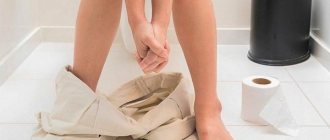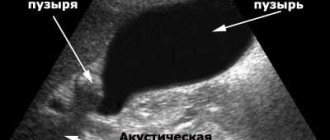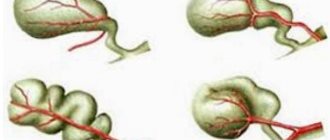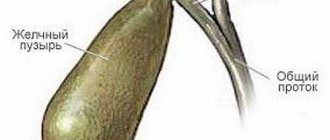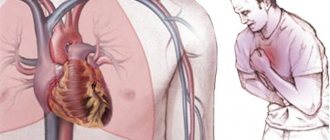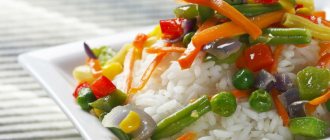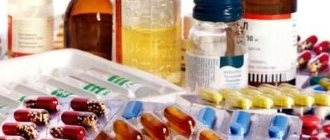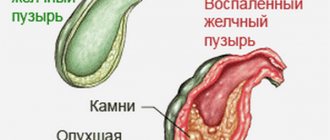Not only folk, but also traditional medicine quite often recommends the use of herbs for cholecystitis and pancreatitis, since long-term use of medications negatively affects the condition of the liver and the body as a whole, which cannot be said about herbal medicine. But even these seemingly safe means can cause harm to the body if you do not know how to use them correctly.
According to the severity of the inflammatory process and the duration of the course, they are divided into:
- Acute cholecystitis.
- Chronic cholecystitis.
Based on the presence of calculi (stones) in the gallbladder and bile ducts:
- Calculous cholecystitis.
- Non-calculous cholecystitis.
In this article we will look at the phytotherapeutic treatment of chronic cholecystitis with and without stones, that is, chronic calculous and chronic non-calculous cholecystitis.
Acute cholecystitis with and without stones is treated in a surgical hospital by surgeons. Therapy in this case should be started immediately after diagnosis.
Self-medication for acute cholecystitis is prohibited due to the development of life-threatening complications!!!
Causes and types of cholecystitis
Inflammation of the gallbladder, or cholecystitis, is one of the most common diseases of the organs responsible for digesting food. Women get it more often than men, with mature and older women at greatest risk.
The causes of this disease are very diverse:
- sedentary lifestyle;
- chronic constipation;
- irregular eating, in which overeating alternates with prolonged abstinence from food;
- side effects of various infections, including the presence of carious teeth;
- bad habits (smoking, excessive drinking, etc.);
- complication of cholelithiasis;
- Quite often, the gallbladder in women becomes inflamed during pregnancy.
In addition, inflammation may be associated with the presence of parasites in the body. Most often, its causative agents are opisthorchid (tiny flatworms, which can be infected if you eat undercooked river fish) and Giardia (flagellated microorganisms). Giardia cholecystitis is milder than other forms, but requires specific treatment using drugs such as furazolidone, metronidazole, fasigin.
Cholecystitis - causes and symptoms
This pathology occurs in 2 forms: acute and chronic. Each of them is specific due to its appearance and symptoms.
Chronitization of the disease is preceded by ignoring therapeutic measures when it appears.
In other words, if a patient neglects his health and ignores the need for treatment for inflammation of the gallbladder, cholecystitis can become chronic.
The pathology rarely worsens. However, if this happens, the patient experiences severe pain in the right hypochondrium, which is felt more intensely if it was preceded by an error in nutrition.
Sometimes a gastroenterologist has difficulty making the correct diagnosis for his patient.
However, experts identify the following causes of cholecystitis:
- Regular overeating.
- Abuse of fatty foods.
- Frequent physical inactivity.
- Infection of the gastrointestinal tract.
- Deformation of the bile ducts (people are born with this pathology).
- Stomach or intestinal cancer. In this case, cholecystitis occurs as a complication of the oncological process.
- Deterioration of metabolic processes.
It is worth noting that this pathology is often provoked by the development of other diseases.
For example, it could be gastritis or pancreatitis. A person suffering from this disease faces not only inflammation of the tissue surface of the gallbladder, but also a violation of the outflow of bile.
Features of the disease
With cholecystitis, the gallbladder is not only inflamed, but also spasmed, which greatly impairs the biliary function. Disruption of the bile ducts can be of two types:
- hypomotor dyskinesia, in which there is stagnation of bile;
- hypermotor dyskinesia accompanied by spasms.
Both of these conditions are accompanied by pain and disrupt metabolism. Only a doctor can establish the correct diagnosis and determine the type of cholecystitis. As a rule, ultrasound is prescribed for accurate diagnosis.
Herbs for the treatment of cholecystopancreatitis
Herbs for the treatment of pancreatitis and cholecystitis are used for various purposes - reducing the inflammatory process, eliminating symptoms such as pain, improving digestion, etc. Therefore, herbal medicine is selected individually for each patient. The regimen depends on the degree of damage to the pancreas and gallbladder, the presence or absence of concomitant diseases, and general health.
According to statistics, pancreatitis is complicated by cholecystitis in 85% of clinical pictures. Therefore, the goal of therapy with folk remedies is to remove stagnation of bile and have an anti-inflammatory effect on internal organs.
Use of herbs depending on the problem:
- To level out bile stagnation, it is necessary to use plants that have choleretic properties.
- For spasms in the biliary tract, decoctions with an antispasmodic effect are used.
- To combat pathogenic microorganisms that provoke inflammatory processes, choose plants that have antiprotozoal, antibacterial and antimicrobial effects.
- If there are liver disorders, then you need to use plants with hepatoprotective properties.
- In the presence of stones, folk remedies of litholic properties are used.
Note that many doctors do not recommend using traditional methods aimed at dissolving gallstones.
The fact is that small fragments can clog the bile ducts or injure internal organs, which is unsafe for health and threatens the life of the patient. So, what herbs can you drink for pancreatitis and cholecystitis? Let's look at the names of plants, properties and principles of action:
- To speed up the production and excretion of bile from the body, plants with choleretic properties are used. Representatives are immortelle, common tansy, peppermint, barberry. Different herbs produce the desired effect in different ways. For example, birch and mint increase the outflow of bile due to an increase in fluid in it, and tansy and corn silk remove bile due to an increase in the tone of the biliary tract.
- Herbs with antispasmodic action - marsh cudweed, anise, dill seeds, fennel, St. John's wort, chamomile, belladonna, black henbane.
Use caution in medicinal decoctions and infusions based on belladonna, henbane, and stinking dope, since the plants contain toxic components that can lead to poisoning.
Goals of herbal medicine for cholecystitis
For chronic non-calculous cholecystitis:
- Relief of pain syndrome.
- Relieving spasm.
- Removing intoxication.
- Hepatoprotection.
- Gastroprotection.
- Increasing vitamin balance.
For chronic calculous cholecystitis:
- Relief of pain syndrome.
- Relieving spasm.
- Elimination of inflammation.
- Choleretic.
- Hepatoprotection.
- Cholelytic action.
- Reducing the amount of bile acids.
- Improvement in general condition.
- Regulation of mineral metabolism.
What herbs and infusions are used, how to brew, dosages, duration of treatment, when the course can be repeated.
Treatment with tincture with the addition of calendula and herbal tea
In case of chronic disease, you should regularly drink tincture from the herbal collection:
- Barberry (bast);
- Common dandelion root;
- Silver birch (leaves);
- Dill;
- Immortelle inflorescences;
- Calendula flowers;
- Common bedstraw herbs.
It’s simple to prepare the tincture: you need to take one tablespoon from all the plants (herbs in equal proportions), put it in a 300 ml container (not iron!), then pour boiling water over it, cover and infuse for about an hour. After this, the collection needs to be simmered in a water bath for about half an hour, cooled and strained, and brought to the original amount (300 ml). You need to drink this mixture with the addition of calendula, one-third of the container three times a day, half an hour before meals.
Sometimes even ordinary tea from calendula inflorescences becomes a good preventive measure against the formation of stones in the bile ducts. It has been proven that treatment with calendula infusions is effective for cholecystitis, but herbalists consider this plant to be an ambulance for pancreatitis and cholecystitis. You can prepare the medicine at home. To do this, you need to pour a tablespoon of calendula flowers with half a glass of vodka and leave for about two weeks.
For inflammation of the pancreas, alcohol tinctures are generally taken, but even a regular hot calendula drink will help ease the process and be an excellent preventive measure. Also, calendula flowers, motherwort and immortelle herbs (in equal quantities) in the form of hot tea will help with the chronic form of the disease. Green tea with these herbs will be an excellent addition to the main treatment.
Treatment of cholecystitis
Methods to get rid of the disease include:
- Following a diet (5 P), which focuses on excluding fatty foods rich in carbohydrates from the diet. Patients can eat vegetables and meat (lean) steamed or boiled. The same applies to vegetable dishes. Some fruits are excluded from the diet. Food should be small and frequent. Alcohol, coffee and strong tea are excluded from drinks. In addition, orange and apple, tomato juices.
- Operation. Surgical intervention is mandatory in the following cases: large stones in the gall bladder;
- symptoms of biliary colic: attacks occur more frequently and are not controlled by medications;
- cholangitis (purulent);
- empyema.
Treatment of cholecystitis using traditional methods. Is it possible to cure a disease forever with the help of herbs? Rather, traditional medicine and herbal remedies should be used as part of complex therapy prescribed by a doctor.
Diagnosis and treatment
Symptoms of cholecystitis
Symptoms of cholecystitis may not appear in full, but only partially and with varying intensity. These may include: sweating, sleep disturbance, bitter taste in the mouth, nausea, intestinal discomfort, increased fatigue, pain in the right side. Cutting acute pain in cholecystitis is the main sign of the acute course of the disease. It is localized under the ribs on the right, but can extend to the epigastric region, the left side of the body, neck, shoulder blade, and shoulder. In addition, vomiting, diarrhea or constipation, a feeling of heaviness in the right side of the abdomen, intoxication, chills, fever, muscle aches, increased PMS, and migraine may occur.
Often the symptoms are similar to other diseases, such as inflammation of the pancreas, so cholecystitis can only be diagnosed by a doctor.
To make a diagnosis, there are a number of methods, such as an extended blood test, urine test, X-ray, CT, MRI, ultrasound, and culture of the contents of the gallbladder is also taken. Several methods are used to treat cholecystitis: conservative therapy, tubage, traditional medicinal methods, which we will discuss below, and surgery. Conservative treatment involves the prescription of medications: antibiotics, antibacterial drugs, anti-intoxication agents, painkillers, parasite killers, antispasmodics, antiemetics, and immunomodulators. Choleretic drugs and a mandatory diet are prescribed. This is the most powerful weapon in the fight against cholecystitis. Animal fats, confectionery products, baked goods, smoked, salted, fatty dairy products are excluded; consumption of canned food, coffee, cocoa, and strong tea is not allowed.
The tube is designed to improve the functioning of the organ by removing bile from the organ. It is performed in two ways: probe and probeless. If conservative methods of combating cholecystitis do not help, surgical intervention is prescribed. The operation is performed laparoscopically and stripwise.
Traditional methods are also used - treatment and prevention with herbs. A method with a minimum of side effects, but the result will not be immediate. Do not forget that even this must be agreed with your doctor.
How is herbal medicine useful?
With cholecystitis, there is stagnation of bile in the organ, which can be overcome by decoctions of choleretic plants. To relieve spasms of the biliary tract, herbs that have an antispasmodic effect are used.
The development of inflammatory processes is stopped by agents that have antimicrobial, antiprotozoal and antibacterial effects, because the infection can spread further.
In the presence of gallstones, infusions with plants that have a litholytic effect are recommended.
And hepatoprotective agents will make the liver function normally.
Doctors do not recommend trying to dissolve gallstones on your own, since the smallest particles can damage internal organs.
Useful plants
To optimize the process of bile formation and its removal, you can take decoctions from the following plants:
- common tansy;
- birch leaves;
- peppermint;
- columns of corn;
- barberry;
- sandy immortelle.
They are divided into two groups: choleretics and cholekinetics. The former enhance the outflow of bile due to an increase in the level of water content in it (mint and birch leaves). And the latter increase the tone of the gallbladder and the pathways through which fluid leaves the body (tansy, corn). Plants such as barberry, sandy immortelle and Chinese aerum have mixed effects, so you need to be especially careful when consuming them.
Cholecystitis often manifests itself as spasmodic attacks, which can be alleviated by effective antispasmodics: cumin, chamomile, anise, fragrant dill, lemon balm, cinquefoil, lily of the valley, calamus, rhombifolia.
Properties of various plants
Treatment of cholecystitis at home is possible if there are no contraindications. To do this, it is better to use herbs available for sale at the pharmacy, or those that grow in nearby forests and fields if you live in an ecologically clean area.
Chamomile flowers are known to help with a variety of ailments. Cholecystitis is no exception. You can prepare preparations in which chamomile will be one of the components - decoctions, tinctures, medicinal teas. Some even practice an enema from a warm decoction of this plant.
Immortelle
At every step you can find plantain. It has a strong anti-inflammatory effect, reduces the level of cholesterol, which is part of the stones found in the gall bladder. The seeds of this plant can be added to food, but it is important to ensure that the amount does not exceed more than 4 tablespoons per day. Patients with increased blood clots and a sick stomach should not prepare decoctions from this herb, but for everyone else they will be an effective remedy.
Chicory has a beneficial effect on the functionality of the hepatobiliary system as a whole. You can use roots, seeds and flowers, and many even drink freshly squeezed juice. It is worth replacing regular coffee with chicory in the morning - the taste of these products is practically no different.
Milk thistle restores liver cells (hepatocytes) and has a powerful anti-inflammatory effect, so it can cure cholecystitis like no other plant material. To prepare decoctions, crushed milk thistle seeds and roots are used. You can use oil, but its effectiveness is delayed in time.
The best herbs for cholecystitis:
- Immortelle. Preparing the decoction is not difficult: we take the crushed flowers of the raw material, add corn silk and St. John's wort. Boil water in a proportion of 200 ml, add one tablespoon of the mixture to it. Cook the mixture for about 30 minutes, cool. Be sure to filter it. The decoction should be taken 20 minutes before lunch or dinner, one-third of a 200 ml glass.
- St. John's wort. Method for preparing the decoction: take a tablespoon of raw materials, pour boiling water into 20 ml. Leave for 20 minutes, strain the resulting broth. Take 20 minutes before lunch or dinner, strained, 0.25 regular glasses per 200 ml.
St. John's wort and immortelle have a choleretic and anti-inflammatory effect on the body.
- Mint. Mint decoctions relieve pain and are used to treat the digestive system. Mint infusions are used for heartburn and belching, and for intestinal spasms. Mint has an anti-inflammatory effect and is a choleretic drug. Recipes for mint decoctions are simple: 1 tablespoon of the raw material is poured with boiling water (200 ml). The composition is cooled and filtered, you can drink half a glass before meals 20 minutes twice a day.
- Chamomile. Chamomile coats the intestines and relieves spasms. It can reduce irritation and relieve inflammation. In the treatment of the gastrointestinal tract, chamomile is used for gastritis, diarrhea, colitis, as well as for diseases of the gallbladder. Chamomile is sold in pharmacies in the form of bags in which finished raw materials are packaged. The bags are brewed according to the principle of simple tea: just put 1 bag in a mug or glass and pour boiling water over it. Cool and drink three times a day before meals.
Choleretic herbal remedies are represented by the following herbs, in addition to those listed above:
- oregano;
- birch, wormwood, yarrow – ready-made collection;
- calendula, knotweed, oregano, mint – ready-made collection;
- dandelion;
- sage as part of the collection;
- lemon balm as part of the preparations;
- horsetail as part of the collection.
Oregano and sage: recipes
Oregano
Recipe for treatment with oregano: pour 1 tablespoon of the original raw material with boiling water in the proportion of one glass (20 ml), leave the composition for about 2 hours. Consume 15 minutes before meals, 1.4 glasses three times a day.
Sage treatment recipe:
Pour 2 tablespoons of sage into 1 glass of boiled water. Infuse the mixture in a water bath for about half an hour, then cool for 15 minutes and strain. The decoction should be consumed 15 minutes before meals, 1 tablespoon three times a day.
Herbs for cholecystitis are freely sold in city pharmacies. They do not require prescriptions.
Oats in the treatment of cholecystitis
If there is no reason for urgent surgical intervention, treatment of cholecystitis with herbs gives good results. But oats, widely used for gastrointestinal pathologies, are also effective. A decoction and infusion of oats are isolated. The decoction is used for intestinal diseases, cholecystitis in children and adults.
Method of preparing oats (decoction):
The oatmeal is soaked in water at room temperature, the mixture sits for one hour. After this, the oatmeal is washed and boiled in two glasses of water for about 10 minutes. Honey is added to the broth in the proportion of 2 tablespoons, the mixture is cooked for another 3 minutes. The first composition is ready. The second composition is prepared as follows: oatmeal (1 glass) is poured with 1 liter of water, boiled for 15 minutes until it forms a liquid jelly. You can add milk to the broth. The decoction is ready. After cooling, mix both compositions together, dissolving honey in them in a ratio of 3 tablespoons. Take a glass of the decoction several times a day.
Oat infusion is used as a choleretic agent. Various methods are used to prepare the infusion. One of them:
A glass of oats is filled with 1 liter of water and evaporated to ¼ volume. The infusion is taken up to 4 times a day, 0.5 tbsp.
Hepatoprotective plants
Herbs with hepatoprotective action include milk thistle, which contains silymarin (the component is the basis of the pharmaceutical preparations “Karsil” and “Legalon”).
Chicory is another good hepatoprotective agent for the treatment of cholecystitis. It is part of many chemical medicines.
Another means of hepatoprotective action is dandelion officinalis (found in the medicine “Essentiale”).
Choleretic herbs
Choleretic plants also include:
- corn silk;
- tansy;
- centaury;
- mint (pepper);
- barberry;
- birch leaves.
All these choleretic plants must be drunk in strict proportions and adhere to a diet. They are divided into cholekinetics (they force the organ to contract and regulate the functioning of all pathways) and choleretics (increase the flow of bile).
Antispasmodic plants
This group of herbs includes mainly umbrella plants (some of them are considered poisonous):
- Anise;
- Fennel; caraway;
- Dill;
- Chamomile;
- Goose cinquefoil;
- Cottonweed;
- St. John's wort;
- Henbane (with caution);
- Datura (with caution);
The last two herbs belong to the nightshade family, they are considered poisonous, they can only be taken as prescribed by a doctor and drunk in strictly specified proportions. Treatment with the above plants is effective for cholecystitis, and the herbal components have a mild antispasmodic effect.
Bitter herbs
Treatment with these plants stimulates the gland and affects secretion. These herbs include:
- sagebrush;
- calamus;
- dandelion;
- watch.
In pharmacy kiosks, these herbs in alcohol are called “bitter tincture.”
Tea mushroom
Kombucha became famous back in the nineteenth century as an indispensable remedy for various diseases. Moreover, it has been proven that kombucha not only helps with various forms of cholecystitis, but is also useful for intestinal diseases and atherosclerosis.
Research has confirmed that kombucha has antimicrobial effects and is effective in treating gallbladder and duct diseases (especially in active people).
By choosing kombucha when treating inflammatory processes in the biliary tract, you can speed up the healing process. Many housewives grow kombucha at home and add it to various traditional medicine recipes. To do this, they purchase a medusomycete, immerse it in sweet and cold tea and wait for it to ripen.
Basically, kombucha is prepared for about 5-7 days in the form of a tincture and taken before meals up to 4 times a day, half a glass.
Treatment with tincture with the addition of calendula and herbal tea
In case of chronic disease, you should regularly drink tincture from the herbal collection:
- Barberry (bast);
- Common dandelion root;
- Silver birch (leaves);
- Dill;
- Immortelle inflorescences;
- Calendula flowers;
- Common bedstraw herbs.
It’s simple to prepare the tincture: you need to take one tablespoon from all the plants (herbs in equal proportions), put it in a 300 ml container (not iron!), then pour boiling water over it, cover and infuse for about an hour. After this, the collection needs to be simmered in a water bath for about half an hour, cooled and strained, and brought to the original amount (300 ml). You need to drink this mixture with the addition of calendula, one-third of the container three times a day, half an hour before meals.
Sometimes even ordinary tea from calendula inflorescences becomes a good preventive measure against the formation of stones in the bile ducts. It has been proven that treatment with calendula infusions is effective for cholecystitis, but herbalists consider this plant to be an ambulance for pancreatitis and cholecystitis. You can prepare the medicine at home. To do this, you need to pour a tablespoon of calendula flowers with half a glass of vodka and leave for about two weeks.
For inflammation of the pancreas, alcohol tinctures are generally taken, but even a regular hot calendula drink will help ease the process and be an excellent preventive measure. Also, calendula flowers, motherwort and immortelle herbs (in equal quantities) in the form of hot tea will help with the chronic form of the disease. Green tea with these herbs will be an excellent addition to the main treatment.
Herbal medicine for acute cholecystitis
After establishing the true cause, which could provoke an acute inflammatory process in the walls of the gallbladder, the gastroenterologist will be able to select the optimal treatment regimen for cholecystitis. Herbs will only complement the main drug therapy for the disease.
As a rule, among the most popular medicinal plants at the stage of acute pathology are chamomile with dill, as well as calendula with fennel. They have not only anti-inflammatory, but also pronounced antispasmodic effects.
It is enough to prepare a fresh decoction or tea with one of the plants, which should be consumed 30-40 minutes before meals, 80-100 ml. Drink warm in small sips. To improve the taste sensation, it is permissible to add a drop of honey, which is also a natural antiseptic.
A simple recipe for herbal tea for acute cholecystitis:
- take 20 g of chamomile flowers;
- pour into a clean container with a tight lid;
- pour in 250 ml of boiling water;
- leave covered for 7-10 minutes;
- filter.
Drink the prepared tea and wait, preferably lying on your right side on a pillow. Eat food no earlier than 30-40 minutes later.
Lemons will also help tidy up your liver.
Inflammation causes changes in the gallbladder and severely disrupts bile-forming function. Therefore, the formation of gallstones is one of the dangerous complications of cholecystitis. To prevent it, traditional medicine advises drinking about a liter of water acidified with lemon juice every day.
For hypomotor dyskinesia, lemon, ground with garlic and honey, helps improve the movement of bile. This mixture should be taken in the morning before breakfast.
But all products that contain lemon are pungent, so they can only be used if the condition of the stomach allows it. And be sure to consult a doctor before taking them.
And in conclusion, I offer a short video about herbal remedies used to treat cholecystitis.
Natural Remedies for Heartburn
How to get rid of heartburn with cholecystitis and protect the mucous membrane of the esophagus and stomach?
Pour boiling water over two or three tablespoons of flaxseed. After a few hours, drink the infusion and eat the seeds. Or simply take a tablespoon of flaxseeds, chew thoroughly and swallow. You can also add flax seed to cooked dishes.
For heartburn, I brew chamomile and drink the infusion almost hot. Some people do not recommend chamomile for heartburn because it is a choleretic agent, but this plant has a very strong anti-inflammatory effect. Therefore, the unpleasant sensations disappear.
Corn silk infusion also protects the stomach and esophagus.
Corn grains are often used in the fight against cholecystitis
In addition, traditional medicine advises using the following remedies for heartburn:
Marsh dry grass. Contraindicated for hypotension and gastric ulcers.
Centaury. Contraindicated for stomach ulcers and diarrhea.
Gentian yellow. Contraindicated in hypertension, pregnancy, lactation.
They have an anti-inflammatory, regenerating effect and improve the functioning of the gastrointestinal tract.
Herbal medicine gives excellent results
Since cholecystitis is accompanied by inflammation, its standard therapy often includes antibiotics and other potent drugs. But treatment with folk remedies can also be very effective, especially if it is carried out under the guidance of a doctor. In this case, the question becomes especially important: what herbs can you drink? If cholecystitis is acalculous, then the set of medicinal herbs that both increase and decrease the tone of the ducts is very diverse. You can even take them on your own without fear.
But if there are already stones in the bladder, then special care is required in this case, since choleretic preparations cause severe pain and can even cause blockage of the bile ducts. Then only emergency surgery can save a person.
In order to determine which herbs to treat a particular person, you must first establish the type of cholecystitis, what caused it, and what concomitant diseases are present. Then you can try different herbal mixtures.
Herbal recipes for hypomotor dyskinesia are mostly based on barberry, immortelle sandy, peppermint and corn silk.
Herbal recipes for hypermotor dyskinesia include rowan, centaury, chamomile, oregano, caraway, shepherd's purse, yarrow, and calamus.
An almost universal remedy that can be used for any type of disease is milk thistle seed oil.
To relieve spasms, you can use anise, fennel, St. John's wort, bloodroot, and rhombifolia.
Along with the use of special preparations, it is recommended to use general strengthening agents, such as ginseng, eleutherococcus, and aralia.
Herbal decoctions and infusions can not only be taken orally, but also added to bath water. Here is a recipe for one of the very effective and surprisingly pleasant procedures: a mixture is made consisting of 5 parts of sweet clover, 10 parts of pine needles, 2.5 parts of small periwinkle, 2.5 parts of calendula, 2 parts of hop cones, 2.5 parts of birch leaves, 1.5 parts mountain arnica, 1.5 parts celandine. One hundred grams of this mixture should be poured with two liters of boiling water and allowed to cool completely. Add the strained mixture to the bath water. The duration of the procedure is 15 minutes.
Herbal recipes for the treatment of cholecystitis
Before treating cholecystitis with herbs, you should consult a doctor, who will recommend the most effective recipe in a particular case and warn about possible side effects.
- You need to take three parts each of dill and mint, two parts each of hawthorn fruit and immortelle herb, and one part chamomile. Grind everything thoroughly, brew in boiling water and keep in a water bath for 15 minutes. Cool, strain and drink 1/4 cup.
- Take equal amounts of a certain amount of string, elecampane and mint. Brew two tablespoons of the mixture with boiling water for 15 minutes, cool, and then drink 1/3 cup a day.
- Pour a glass of boiling water over calendula flowers (1 tablespoon), leave for 8 hours in a dark place, carefully covering, drink 1/3 glass every day.
- Wash oats (100 g) in several waters, pour boiling water (1.5 liters) and cook for about an hour over low heat. After 40 minutes, when the oats have softened, crush them with a masher or wooden spoon. The decoction should be taken before each meal (3-4 times a day) 100 g.
- A decoction based on St. John's wort will be effective. Pour 200 ml of boiling water over a tablespoon of herb, leave for 20 minutes and strain. Drink 1/4 glass of 200 ml 15 minutes before meals (lunch or dinner, but not breakfast).
- Mint is prepared in the same way, only it is infused for 2 hours, taken 2 times a day, 1/2 cup a few minutes before meals.
- You will need the following herbal collection: ½ teaspoon of crushed marshmallow root; ½ teaspoon of cumin seeds; 1 teaspoon of crushed peppermint leaves, 1.5 teaspoons of crushed sea buckthorn bark, 1.5 teaspoons of crushed medicinal sage leaves.
All ingredients are mixed, poured with 0.5 liter of boiling water, then the container must be placed in a water bath and heated for 20 minutes.
The strained mixture is taken 20 minutes before meals. If the stool is normal, then one glass is enough, but if you suffer from constipation, then the dose is increased to two glasses.
- The method of preparing this mixture is the same as in the previous recipe, and the selection of herbs for it is as follows: one and a half teaspoons of peppermint leaves, chamomile, lemon balm. Take 1/3 cup of the prepared mixture 20 minutes before meals.
- The following tincture is great for soothing an inflamed gallbladder. Ingredients: 2.5 teaspoons each of celandine herb and peppermint. The preparation and administration scheme is the same as in the first recipe. You can take this medicine for two months, then you need to take a break.
- During subsequent exacerbations of chronic cholecystitis, a herbal collection of the following composition helps well: ½ teaspoon each of wormwood, mint, immortelle flowers, dandelion root, buckthorn bark, plus two teaspoons of madder root. Preparation and dosage regimen are similar to the first recipe.
These infusions should be taken before meals!
Herbal recipes for pancreatitis and cholecystitis
Decoctions
People suffering from cholecystitis and pancreatitis should consult their doctor before starting a course of auxiliary therapy, including decoctions of medicinal plants. If cholecystitis is not complicated by the presence of gallstone disease, the following universal decoction can provide support to the body:
- Take 2 parts each of barberry, chamomile and nettle leaves.
- Then 3 parts each of rose hips, St. John's wort and oregano.
- Then take 5 parts each of plantain, calendula, knotweed and yarrow.
Having prepared a decoction from the components listed above, you should consume it 3 times a day, 100 ml, shortly before each meal, for a course lasting from one and a half to two months.
Recommended video:
Persons diagnosed with “hypermotor form of cholecystitis” or “chronic pancreatitis” can be recommended a decoction based on the following herbal mixture:
- Take mint, celandine and nettle in equal proportions.
- Then add 2 parts each of cinquefoil, chamomile and knotweed roots.
Dandelion roots, plantain leaves, caraway seeds and St. John's wort are also added to the mixture. It is recommended to use this collection in the form of a decoction during the period of remission for a course lasting from 3 to 5 weeks.
Tinctures
Alcohol, even in small quantities, is contraindicated in both acute and chronic forms of pancreatitis. Ethanol disrupts the supply of pancreatic cells with nutrients and oxygen, which aggravates the patient's condition. Therefore, it is worth using tinctures of medicinal plants and herbs with great caution only during the period of remission and under the supervision of a physician.
In the case of chronic pancreatitis, barberry tincture can help, take 1 tsp. twice a day. Alcohol tincture of krifea is used for chronic pancreatitis in the amount of 17-18 drops 3 times a day.
This remedy eliminates secretory pancreatic insufficiency and stabilizes the digestive process. For preventive purposes, tinctures of calendula, echinacea and eleutherococcus roots can be used.
Therapeutic exercises and proper nutrition
Light physical activity in the form of special exercises will help cure the disease. However, doctors do not recommend performing them if stones are detected in the organ.
- Get on all fours, inhale, bend your arms, lie on your stomach, exhale. Return to starting position.
- Lying on your back, hands on your waist, raise your shoulders and head, directing your gaze to your toes, exhale. Return to the starting position and inhale.
- Lying on your left side, raise your right arm and leg and inhale. Pull your knee towards your stomach, exhale.
In addition, the treatment of cholecystitis is facilitated by following special nutritional rules. The patient will have to give up sour fruits and berries, legumes. Doctors do not allow eating marinades, smoked foods, mustard and horseradish. Fresh pastries and cakes are also contraindicated. It is worth limiting yourself in drinking coffee, carbonated and alcoholic drinks.
In the morning on an empty stomach, it is recommended to take a tablespoon of a mixture of lemon juice and olive oil. And 20 minutes before a meal, you can drink a quarter of the juice obtained by squeezing one grapefruit.
Winter preparations, for example, sauerkraut brine mixed with tomato juice in equal parts, can also help in the treatment of cholecystitis. Just a glass of this mixture a day will relieve attacks of cholecystitis and help restore the functionality of the gallbladder. Pumpkin and its juice (also a glass a day) have a similar property.
At the first signs of exacerbation of cholecystitis, you must call an ambulance.
Cholecystitis can be cured thanks to a whole range of measures, which includes regular cleansing of the gallbladder and liver, fasting days, avoidance of salty, fatty foods, marinades, taking herbal remedies and herbal decoctions, and feasible physical activity. It is advisable to discuss all treatment methods, including home ones, with your doctor to avoid unpleasant consequences in the future.
Effective remedies against cholecystitis
The most effective remedies for the treatment of cholecystitis, which are recommended by traditional medicine specialists, should not harm the body. They affect the processes of bile outflow, have antispasmodic, anti-inflammatory and analgesic effects. In the initial stages, cholecystitis can be completely cured if you take one of the useful folk remedies:
- a day they eat half a glass of the mixture, which is obtained by infusing 500 g of oats with a liter of boiling water;
- freshly squeezed cabbage juice is another remedy for folk treatment of gallbladder diseases; you need to drink 500 ml in small portions per day;
- half a glass of a mixture of sunflower or olive oil in combination with grapefruit juice (in equal proportions) is drunk 2 hours after the last meal;
- a decoction of peeled crushed beets - keep it over low heat until thickened, and then take a quarter glass three times a day.
Treatment of chronic cholecystitis is a long process. Even pharmaceutical drugs cannot relieve the symptoms of this disease immediately after taking them, and natural remedies contain active ingredients in lower concentrations. They have the advantage of being accessible and safe, and they rarely cause side effects. However, before starting treatment for inflammation, you should consult a doctor and find out about all the nuances of the disease. Those drugs that are completely safe for adults can cause exacerbation of cholecystitis in children; the presence of other pathologies in the anamnesis should also be taken into account.
Tubazh
This procedure is possible even at home. The main task of tubage is the outflow of bile. During the procedure, the bladder and outflows, as well as the liver, are cleaned. In addition, the patient’s constipation disappears and intestinal function improves.
The procedure is carried out as follows: on an empty stomach, drink a glass of warm purified water or a decoction of a choleretic plant. After half an hour, you need to drink apple juice (warm), a few tablespoons of olive oil, or just warm water with a spoon of honey. After this, you need to drink a glass of slightly sweetened warm tea and lie down on your left side, placing a heating pad on your right side.
After the tubage, you need to take a deep breath (several times), do squats and have a light breakfast. Some people may experience loose stools or mild pain in the right hypochondrium. But there's no need to worry. This occurs due to excessive contraction of the gallbladder. To avoid this, you can take a herbal antispasmodic.
Whatever method of traditional medicine you choose, it is important to follow the instructions and consult a specialist. Each of the above methods can be effective in the treatment of cholecystitis and pancreatitis. The main thing is to choose the appropriate treatment method for yourself and consult a doctor.
Contraindications to the use of herbs
Decoctions and infusions of medicinal herbs and plants, as a rule, have fewer side effects than artificially synthesized pharmaceuticals. However, they also have certain contraindications.
Before starting a course that includes auxiliary products of plant origin, you should make sure that there are no allergies or individual intolerance to individual components of the herbal collection.
Herbal remedies are contraindicated during periods of exacerbation of cholecystitis or pancreatitis, with severe gastrointestinal lesions, during pregnancy, lactation and with unstable blood pressure.
Recommended video:
Read along with this article:
- What is herbal medicine for pancreatitis?
- Flaxseed oil for pancreatitis: can it be consumed?
- What juices can you drink for pancreatitis? Which ones are not allowed?
- Is it possible to eat celery during pregnancy, general...
- Chronic pancreatitis. Treatment with folk remedies: the best recipes
- How to properly use choleretic herbal teas
- What folk remedies for cholecystitis help reduce inflammation?
- How to treat cholecystitis and pancreatitis: causes and symptoms...
- Folk remedies for the treatment of pancreatic diseases
Contraindications for the treatment of cholecystitis with herbs
Herbal medicine is contraindicated if:
- The patient has allergic reactions to the components of the preparation.
- The patient has allergic reactions that occurred during treatment with phytotherapeutic drugs.
- As the only therapy for severe conditions, such as severe pain, dyspeptic and intoxication syndrome.
- In case of incomplete examination, when the diagnosis of chronic cholecystitis must be differentiated from other diseases of the gastrointestinal tract and when acute cholecystitis is suspected!!!
- With frequent recurrent biliary colic, when, despite the absence of an acute process, surgical intervention may be required.
Herbal medicine can be used, but with caution:
- For self-treatment with an established diagnosis of chronic cholecystitis.
- If the patient's condition worsens. Only a doctor will be able to tell what is causing the deterioration in a given patient and make the necessary decision on further treatment tactics. But remember, seek medical help as soon as possible if your condition worsens!
- During pregnancy, it is necessary to individually select herbal medicine depending on the duration of pregnancy and concomitant diseases.
- When breastfeeding, I also recommend not to select herbs on your own, but to consult your doctor, since all herbs pass into the baby’s body through breast milk.
Choleretic herbs for cholecystitis are an effective addition to drug treatment
Choleretic herbs must necessarily have antispasmodic or tonic properties, depending on what processes predominate in the smooth muscles of the gallbladder and bile ducts. This allows you to relieve pain.
Stagnation in the gallbladder will certainly cause stagnation in the bile ducts, which will also affect the functioning of liver cells. When stagnant, bile becomes viscous, reducing its ability to emulsify fats and activate digestive enzymes. Therefore, choleretic preparations should include herbs that help thin and reduce the viscosity of bile.
Chronic cholecystitis is always accompanied by dysfunction of other digestive organs - the pancreas, stomach and intestines. In order for the treatment of cholecystitis to be complete, it is necessary to identify and treat these disorders. Therefore, choleretic preparations include plants that normalize the function of other affected digestive organs. Herbal medicine also helps restore the vitamin and mineral balance in the body, reduce intoxication, and improve the general condition of the patient.
Herbal medicine for chronic cholecystitis
Choleretic herbs for cholecystitis are best selected individually, depending on the patient’s condition and the prevalence of certain symptoms. The introduction of choleretic herbs into complex treatment during exacerbation of the disease makes it possible to reduce the dosage and side effects of chemical drugs and enhance (potentiate) their positive effect. The therapeutic effect of taking choleretic herbs develops more slowly, but lasts longer. This allows their use as an auxiliary treatment for chronic cholecystitis. During exacerbation of chronic cholecystitis, treatment is aimed at eliminating pain and dyskinetic (motor - spasms or atony of smooth muscles of the gallbladder) disorders, suppressing infection and the inflammatory process, eliminating digestive and metabolic disorders:
- take one part of calendula flowers, dill fruits, birch leaves, juniper fruits, two parts of chamomile flowers, strawberry fruits, three parts of horsetail grass, corn silk, rose hips, dandelion roots, four parts of immortelle flowers, mix everything; pour a teaspoon of the collection into 0.5 liters of boiling water, leave for 30 minutes, take during the day half an hour before meals;
- take one part each of St. John's wort and centaury herbs, mullein flowers, two parts of watch leaves, three parts each of dandelion roots, immortelle flowers and chamomile, mix everything, prepare an infusion and take it in the same way as the previous one.
In a state of remission, choleretic herbs for cholecystitis are prescribed as anti-relapse treatment in the autumn-spring period. For this purpose, the following collection is suitable: take two parts of mint leaves, one part each of valerian roots, St. John's wort, hop cones, mix everything, prepare an infusion and take it in the same way as the previous one.
